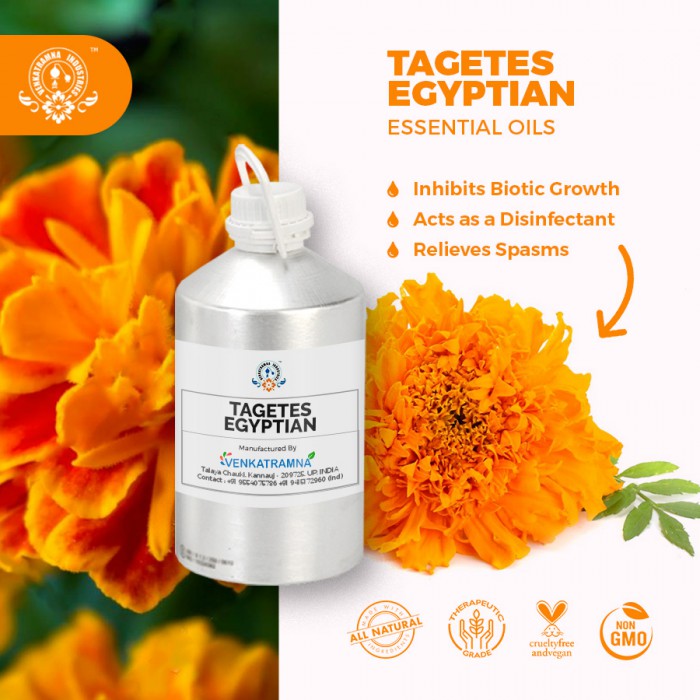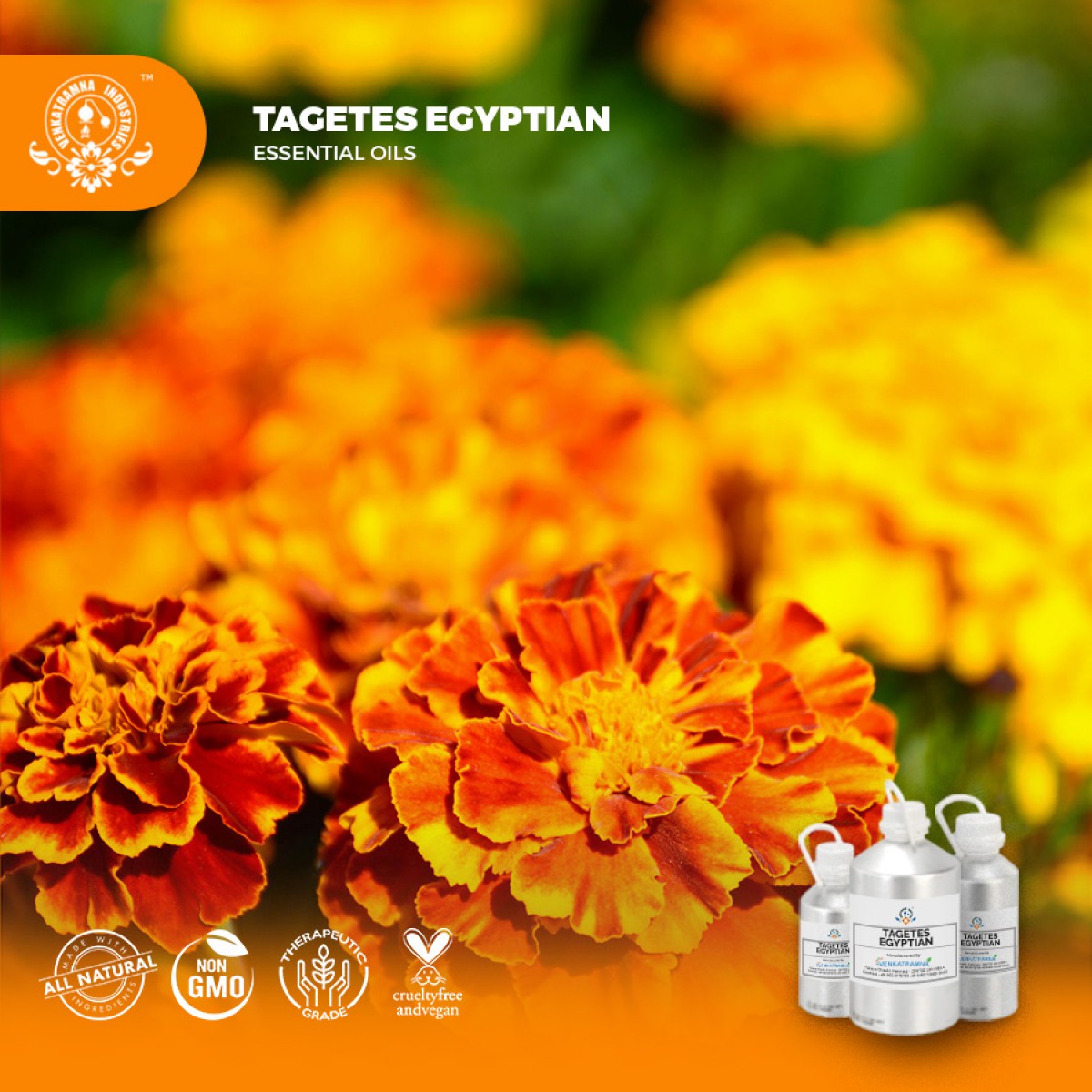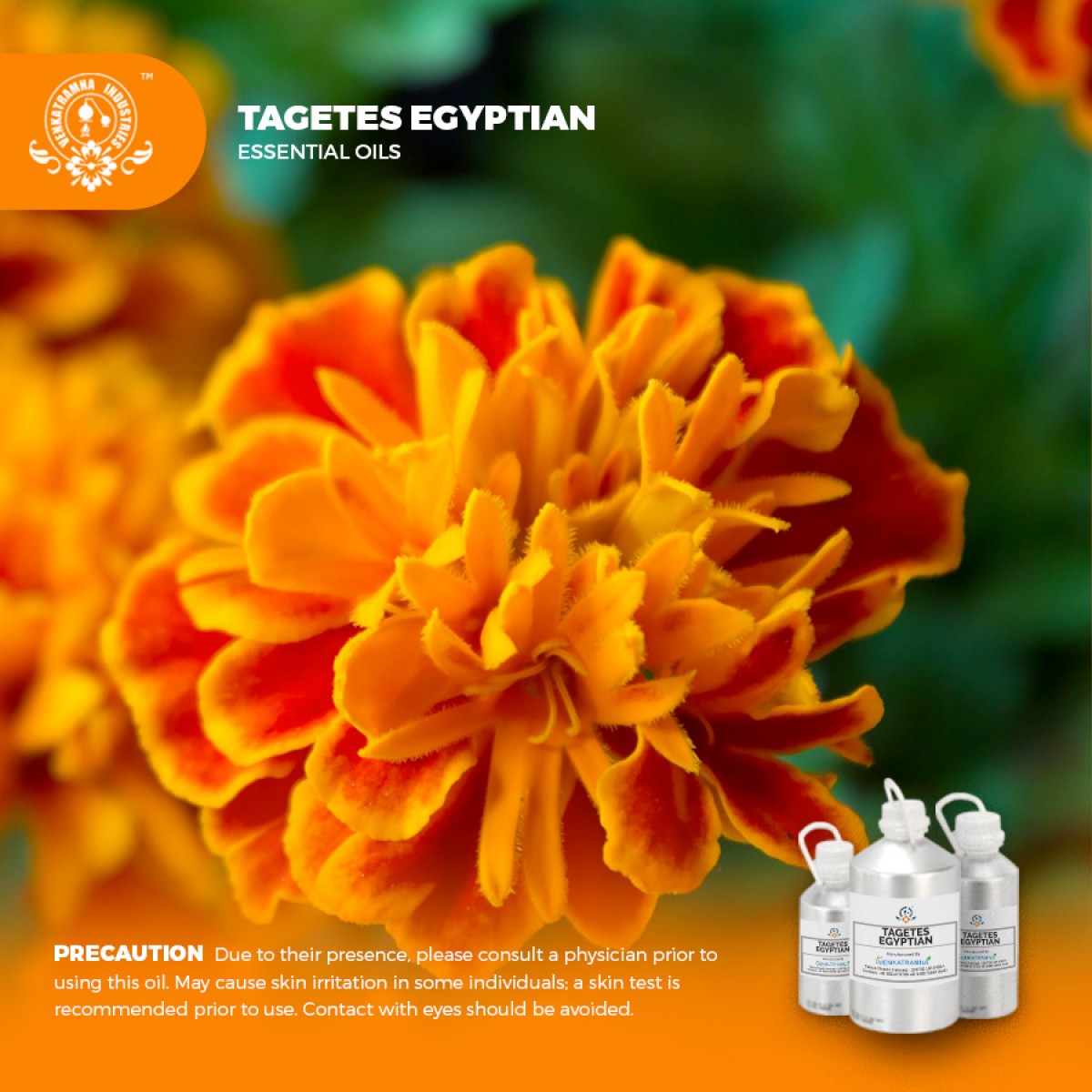Botanical Name: Tagetes minuta Common name: Huacatay, chinchilla, chiquilla, chilca, Read More
|
Botanical Name: |
Tagetes minuta |
|
Common name: |
Huacatay, chinchilla, chiquilla, chilca,
zuico, suico, anisillo, Marigold |
|
Plant
family: |
Asteraceae |
|
Genus: |
Tagetes |
|
Appearance/Color: |
A slightly viscous, reddish to yellowish liquid. |
|
Odor: |
A top note with a medium aroma, Tagetes is easily classified as
sweet, fruity and almost citrus-like. |
|
Blends With: |
Juniper, Lavender, Pine, Geranium, Sandalwood, Jasmine,
Frankincense and all Citrus oils. |
|
Origin: |
Egypt |
|
Source: |
Flowers |
|
Method
of Extraction: |
Steam Distillation |
Tagetes minuta (T. minuta) is a tall upright marigold plant in the sunflower (Asteraceae) family. Tagetes species originally has been used as a source of essential oil (extracted from leaves, stalks and flowers) for the flavoring in the food industries. The powders and extracts of Tagetes are rich in the orange-yellow carotenoid and are used as a food color for foods such as pasta, vegetable oil, margarine, mayonnaises, salad dressing, baked goods, confectionery, dairy products, ice cream, yogurt, citrus juice, mustard and as colorant in poultry feed. T. minuta is also extensively used medicinally as a condiment and herbal tea in a wide variety of fields in its native region and as a popular traditional folk remedy and in the complementary and medical therapy. T. minuta has several medical benefits such as remedy for colds, respiratory inflammations, stomach problem, anti-spasmodic, anti-parasitic, anti-septic, insecticide and sedative. It is used for chest infections, coughs and catarrh, dilating the bronchi, facilitating the flow of mucus and dislodging congestion and can be used in cases of skin infections. It also has a healing effect on wounds, cuts, calluses and bunions. However, such practices are largely based on folklore and train of traditional medicine rather than evidence-based research.
DISCLAIMER
The complete range of conditions
or methods of use are beyond our control therefore we do not assume any
responsibility and expressly disclaim any liability for any use of this
product. Information contained herein is believed to be true and accurate however,
all statements or suggestions are made without warranty, expressed or implied,
regarding accuracy of the information, the hazards connected with the use of
the material or the results to be obtained from the use thereof. Compliance
with all applicable federal, state, and local laws and local regulations
remains the responsibility of the user.
The FDA has not evaluated the
statements on this website. No claims are made by Venkatramna Industries as to
the medicinal value of any products from vriaroma.com or by us. The information
presented here is for educating our customers about the traditional uses of
essential oils and is not intended to diagnose, treat, cure, or prevent any
disease. You are responsible for understanding the safe application of these products.
If you have any questions, please call or email us for further information.
As per NAHA guidelines, New Directions Aromatics
(NDA) does not recommend the ingestion of essential oils. It is imperative to
consult a medical practitioner before using Essential Oils for therapeutic
purposes. Pregnant and nursing women and those taking prescription drugs are
especially advised not to use this product without the medical advice of a
physician. The oil should always be stored in an area that is inaccessible to
children, especially those under the age of 7.
The whole plant is anthelmintic,
antispasmodic, aromatic, diaphoretic, diuretic, purgative and stomachic. It is
used internally in the treatment of gastritis, indigestion and internal worms.
Externally, it is used to treat haemorrhoids and skin infections. The plant is
harvested when in flower and dried for later use.
T. minuta has several medical benefits such as remedy for colds,
respiratory inflammations, stomach problem, anti-spasmodic, anti-parasitic,
anti-septic, insecticide and sedative. It is used for chest infections, coughs
and catarrh, dilating the bronchi, facilitating the flow of mucus and
dislodging congestion and can be used in cases of skin infections. It also has
a healing effect on wounds, cuts, calluses and bunions.
Tagetes essential oil has a
strong, warm, sweet-herbaceous, distinctive ketonic (pungent) aroma with a very
powerful fruity undertone, reminiscent of green apple. Despite its unusual
pungency, Tagetes essential oil is used extensively in French perfumes,
although in minimal amounts. Tagetes essential oil contains about 47% ketones -
accounting for its intense aroma and its benefits in respiratory uses.
COMMON
USAGE
·
Prevents parasites
·
Prevents microbial infections
·
Prevents sepsis
·
Inhibits biotic growth
·
Relieves spasms
·
Acts as a disinfectant
·
Eliminates insects
·
Sedates inflammation
Ingredients:
|
S.No |
Key Constituents |
Strength (%) |
|
1 |
(Z)-b-ocimene |
31.0-43.3 |
|
2 |
Dihydrotagetone |
3.0-22.0 |
|
3 |
(Z)-tagetone |
4.8-10.7 |
|
4 |
(Z)-tagetenone |
4.8-10.3 |
|
5 |
(E)-tagetenone |
4.2-7.8 |
|
6 |
(P)-limonene |
2.9-6.8 |
|
7 |
(E)-tagetone |
0.6-2.0 |
|
8 |
Germacrene |
1.0-1.3 |
|
9 |
b-caryophyllene |
0.6-1.1 |
Safety Summary
·
Hazards phototoxicity
·
Contraindications (dermal) If applied to
the skin at over maximum use level, skin must not be exposed to sunlight or
sunbed rays for 12 hours.
·
Maximum dermal use level 0.01%
Organ Specific Effects
·
Adverse skin reactions: Undiluted taget
oil was moderately to markedly irritating to rabbits. Tested at 2% on 25
volunteers it was neither irritating nor sensitizing. In one RIFM report taget
oil was non-phototoxic. However, subsequent unpublished research by RIFM, using
both oils and absolutes from Tagetes minuta and Tagetes patula, apparently did
find distinct phototoxicity, and indicated similar phototoxic potential for
taget oils and absolutes. A noeffect level of 0.05% for phototoxicity was
determined on humans using Egyptian T. minuta absolute. T. patula oil was
reported to cause ACD in an aromatherapist. However this was not an essential
oil it was an acetone extract, and it was never established that the extract
had even caused the reaction.
Systemic Effects
·
Acute toxicity: Taget oil acute oral LD50
in rats 3.7 g/kg; acute dermal LD50 in rabbits >5 g/kg. Taget oil acute ip
LD50 in rats 0.45 g/kg.
·
Carcinogenic/anticarcinogenic potential: No
information was found for taget oil or absolute, but neither contains any known
carcinogens. (þ)-Limonene displays anticarcinogenic activity.
·
Serious eye damage / irritation No
additional Data available.
·
Respiratory or skin sensitization No
additional data available.
·
Germ Cell Mutagenicity No additional data
available.
·
Reproductive toxicity No additional data
available.
·
STOT-single exposure No additional data
available.
·
STOT-repeated exposure No additional data
available.
·
Aspiration hazard: No additional data
available.
·
Photo-toxicity: No additional data
available.
·
Ecotoxicity: Toxic to aquatic life with long
lasting effects. The product must not be allowed to run into drains or
waterways.
·
Bioaccumulation: No data available
·
Mobility in soil: No data available
·
Persistence and degradability: No data available
·
PBT and vPvB assessment: No data available
Avoid direct
exposure into water streams and ground water sources.





 MSDS-Tagetes.pdf
MSDS-Tagetes.pdf




